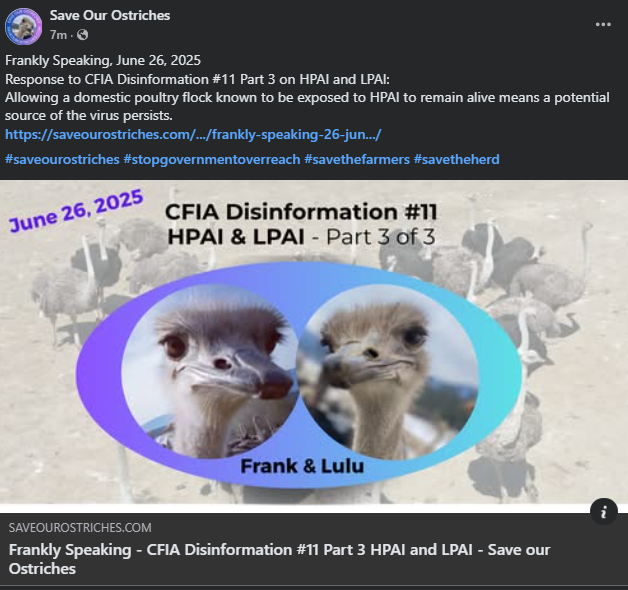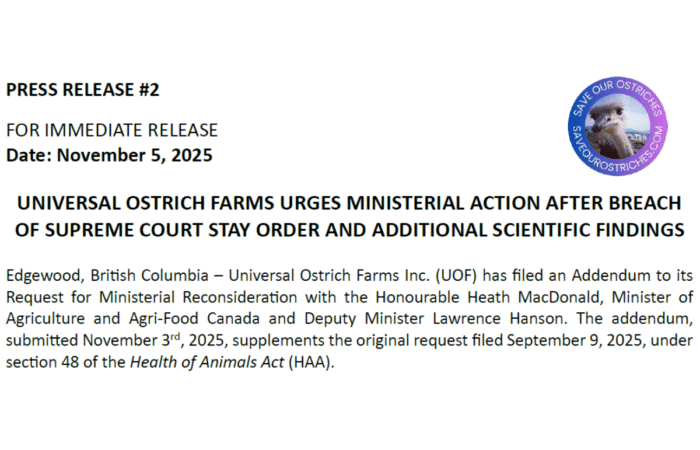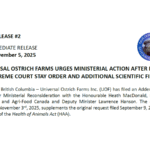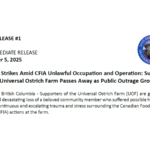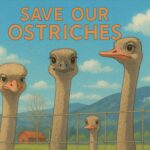June 26, 2025

Edgewood, BC
Disinformation Response to two CFIA Statements (May 31, 2025):
- Update on the CFIA’s actions at an HPAI infected premises at a BC ostrich farm
- CFIA’s basis for applying disease control measures at an avian influenza infected ostrich farm
CFIA Disinformation #11 Part 3 of 3 – HPAI and LPAI: Allowing a domestic poultry flock known to be exposed to HPAI to remain alive means a potential source of the virus persists.
The Experience at the Universal Ostrich Farm (UOF)
A Science-based Reality — Not a Model-based Theory
The UOF flock was not culled. The birds showed temporary clinical signs, recovered naturally without intervention, and are now healthy and thriving. Sequencing conducted by CFIA’s Winnipeg lab confirmed a hybrid strain—containing both HPAI and LPAI elements—indicating low virulence.
We are now well beyond the typical 14-day incubation period, and no spread has occurred to other animals or farms in BC.
Scientific Benchmarks Support Our Case:
- 3–7 days: Most birds infected with avian influenza show clinical signs within this period (WHO, 2006).1
- 14 days: If birds survive beyond this window without high mortality, they likely faced LPAI or a low-virulence form of HPAI (Swayne, 2017).2
- >75% mortality within 2–4 days is characteristic of confirmed, high-pathogenic HPAI outbreaks (Capua & Alexander, 2009).3
Additionally, no new avian influenza outbreaks have been reported by CFIA on any British Columbia farms since January 11, 2025—over six months ago.4 So where is the transmission?
Our Case Offers Real-World Evidence
CFIA’s current response appears to rely more on model-based predictions than on actual clinical outcomes. In our situation:
- The illness did not follow a typical HPAI pattern.
- The birds recovered fully.
- No onward transmission has occurred.
This is not theory—it is documented evidence of a successful containment and recovery.
A One-Size-Fits-All Policy Fails to Consider Real Science
CFIA continues to treat all H5 detections as if they are automatically high-pathogenic HPAI which:
- Ignores important clinical distinctions,
- Fails to reflect current scientific understanding, and
- Has resulted in the culling of over 13.8 million animals on over 538 farms in Canada under the pretext of HPAI eradication.4
This is not just unnecessary—it is economically harmful, scientifically weak, and ethically troubling.
Our Call to Action
We urge CFIA and responsible authorities to take the following steps:
- Stop mislabeling all H5 detections as confirmed HPAI before full pathogenicity testing.
- Acknowledge farm-level outcomes, especially in cases with low mortality or no transmission.
- Base decisions on multiple forms of evidence—PCR testing, serology testing, clinical signs, and confirmed genome sequencing—not modeling alone.
- Recognize the value of naturally recovered, antibody-positive birds. These animals may be key to future research and resilience—not automatic culling targets. The UOF ostriches may be a valuable source of antibodies for research, diagnostic and therapeutic purposes.
Culling healthy, recovered, and non-contagious birds is not science-based policy. It undermines public trust, wastes valuable life, and disregards important data.
Conclusion
We are calling on CFIA to restore scientific rigor, transparency, and responsibility to its decision-making.
This is more than a policy concern—it is a matter of public accountability and ethical governance.
What’s happening now is an avoidable loss—of life, of livelihoods, and of trust.
Our case shows a better way forward—guided by real-world evidence, practical wisdom, and common sense.
References
1. World Health Organization (WHO). (2006). Avian influenza: Guidelines for control. (“bird flu”) – Fact sheet. https://afrohun.org/wp-content/uploads/2021/01/WHO-Avian-influenza-factsheet.pdf
2. Swayne, D. E. (2017). Avian Immunology (2nd ed.). Academic Press. Advances in avian influenza research. Journal of Poultry Science. https://onlinelibrary.wiley.com/doi/10.1002/9780813818634.ch192.
3. Capua, I., & Alexander, D. J. (2009). Avian Influenza and Newcastle Disease: A Field and Laboratory Manual. Springer. https://link.springer.com/book/10.1007/978-88-470-0826-72
4. Canadian Food Inspection Agency (CFIA). (2025). Avian influenza updates (No BC outbreak since January 11, 2025) – https://inspection.canada.ca/en/animal-health/terrestrial-animals/diseases/reportable/avian-influenza/latest-bird-flu-situation/investigations-and-orders
Additional References
5. Swayne, D. E. (2008). Avian influenza control strategies. Avian Diseases, 52(3), 263–277 https://bioone.org/journals/avian-diseases/volume-52/issue-3/8229-012508-Reg.1/Using-Mean-Infectious-Dose-of-High–and-Low-Pathogenicity/10.1637/8229-012508-Reg.1.short
6. World Organization for Animal Health (WOAH). (2021). Avian Influenza updates. https://www.woah.org/en/disease/avian-influenza/
7. Respondents Application UOF vs CFIA Court Document – Pg. 635 – s.22 – “Most ostriches will recover in about 2 weeks)”
8. OIE / WOAH. (2021). Avian Influenza. https://www.woah.org/en/disease/avian-influenza/
Lulu has joined Frank … Fed Up with Feds Falsehoods. Tune in regularly for Frankly Speaking episodes in the CFIA Disinformation series.
Media Contact:
Katie Pasitney
Spokesperson, Eldest Daughter, Universal Ostrich Farm
1-250-870-8246
Share This Story
